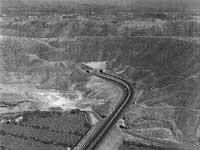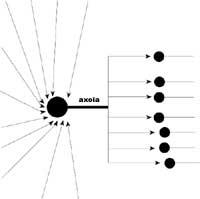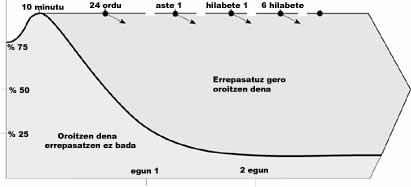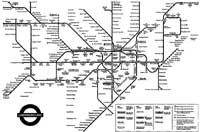Memory
When we need a certain information we look in memory and, as the reader knows, sometimes we do not find it. However, if we have saved the information correctly, most of the time it is easy to find what we are looking for. There are things and events that we would like to forget and that unfortunately come to mind more than we would like. Therefore, we see clearly that memory, at least to a large extent, is out of our will.

For memory to work, the brain must be fine. When we want to run, we know that the bones, muscles and nerves of the legs have to be fine, to remember exactly: the brain must be well, fairly mature and without injuries. Just as young children gradually acquire the ability to walk due to immaturity, they also slowly acquire the capacity of memory, which will reach as the brain arrives.
Just as the one who has broken a leg bone cannot run, the one who has suffered a brain injury may not be able to properly use the memory capacity. Once the bone is formed, we could go crazy; even in cases where the brain injury has been quite high, memory capacity recovery can be difficult. In the same way that those who do not have legs will not be able to walk properly, those who have brain injury will not have the right memory. Unfortunately, this situation often occurs as a result of accidents.
Just as older people "harden" their bones, memory also weakens, loses agility. But let us not make laws of this statement, for all the elders are not hardened by the bones alike and the memory does not fall the same. Old age is not enough for a person to stay out of bed, or to lose memory.
It is because the person who has remained still has suffered a disease that has led him to lose his memory significantly, as is the case of Alzheimer (disease that causes the rapid death of neurons and hence the memory loss suffered by patients). Memory loss caused by a disease only affects 10% of those over 65 years of age and 20% of those over 80 years of age.
Following the same example, it is known that the ability that all people have to run is totally different and the same happens with the memory capacity: those who have a suitable body for the race will adapt more easily and those who have a more suitable brain to evoke the birth will have more ease of memory. However, innate does not totally condition capacity.
Just as physical capacity can be improved with training, it can also improve memory. In this workshop we will explain some techniques to increase your memory capacity. But do not be deceived, each has its limits and walking outside them is not possible, much trained and knowing the proper techniques. Under the eyes of Sabino Padilla and with 16-hour workouts, do you think you would do exploits in Indurain?
Biological basis of memory
In recent years much has been worked in this field of research to improve the knowledge of the physiology of memory. The brain is made up of cells called neurons. Neurons have a kind of tail called body and axon. The axon has many branches that can contact some other neuron through the structure called synapsis. In addition, with each neuron they can believe the axon branches of many other neurons. Therefore, in each neuron you can receive messages from many other neurons and each neuron can leave its messages in many others.

In this way many circuits are generated, so the brain is a complex network of circuits formed by neurons that relate to each other.
Each time we save the new information, we open a new circuit in which circulation will be facilitated by functional changes in activated neurons. If time has passed and this circuit is not used, these functional changes will disappear and traffic will be as difficult as before, which will make us forget the information. On the other hand, if we review this information, there will be structural changes of these neurons and the information will leave a more lasting indication; in these circumstances it is said that the information has left a mark, a mnésico hint. (See image page 10).
If after birth no more neuron occurs and the neurons that die every day are not renewed (although we take good care, neurons are lost every day and no news arise, every day we have fewer neurons), how is it possible that every day we increase memory capacity? Although we lose ourselves every day, we have many neurons that are continually making new synapses and opening new circuits. Therefore, memory loss is not appreciated until the number of neurons drops markedly. These spectacular losses occur as a result of a serious accident, alcoholism or Alzheimer's disease.
How to improve memory?
When is it said that a person has good memory? Of course, when you get the information you want. Therefore, the techniques to improve memory capacity are those that favor access to information. For this it is necessary to keep the information “well”. And what can we do to do it?
To begin with, we will repeat the information, as it leaves a mark, it is more difficult to lose that information we have repeated. The more we repeat the information, the more accessible it will be (the graph above shows the time in which we have to review in order not to forget a certain information). On the other hand, the information should be well organized, as in the house cabinets, as storage criteria should be included in the memory. As you know well those who work on the computer, it is useless to save the information if we do not know where we keep it. Therefore, making schemes is very useful, let us not forget that in our mind we also keep things in the scheme.
We reflect the scheme we have used in the mind on paper, so when we want to review the information we will do it much faster. Against what many believe, therefore, to make schemes is not to waste time. In any case, do not forget that everyone organizes the information in their own way and, therefore, your scheme is of great help to review it you, not anyone. In addition, when we relate what we learn to what we know, that is, when we create links, we integrate new information into the network of our knowledge. In this way, we link the information with more channels and we will have more possibilities to access it, more channels (see image page 13).
Sometimes we have to save information that for us does not mean much (listings, numbers, etc. ). ), if we turn this information into information relevant to us, we will save it more easily and therefore be able to access it more easily. This is the basis of several mnemonic rules.

Some of these techniques are:
- Form expressive phrases in the first letter of the words in the list (for example, to remember the strips of the bones).
- Imagining images, it is based on this well-known method of Loci. You can also make drawings (see image page 13).
- Inventing stories. Each, of course, will create his own, composed of things that are significant to him.
In addition to those already mentioned, there are more ways to improve memory, for example creating motivation. As is known, we have a greater tendency to remember what generates curiosity, since we try to collect information on this subject in all the possibilities that we have and, as with the puzzle, the more pieces we have placed, the easier the placement of the following pieces. In addition, we return many times to what interests us and therefore reorganize and repeat information continuously.

We can turn information into something pleasant for us (inventing stories) or think about the good consequences that something will bring us (this is especially useful when you are preparing examinations). On the other hand, it is known that things that are unpleasant are easier to remember than pleasant things and the latter are nothing pleasant/not unpleasant. Thanks to this we learn well things that harm us, so that we do not forget. The things we like we also remember right away and that largely regulates our behavior. So why not give yourself a small reward as you reach your goals? It is certainly a good way to increase motivation and therefore improve memory capacity.
You have to learn the factors that influence memory capacity, but the subject seems boring to you. With this lesson you have decided to invent a story: “I work in a library. I want to do my work with order and when asked for a book I would like to find it immediately. To begin with, I will have to keep the books well. I will organize the books by topic and within each subject I will place the copies alphabetically—organization. Making a small sketch of the library will not hurt me because they will know — scheme — where books of different subjects are kept. I will put together books on similar subjects, such as nursing and medicine, together with biology, psychology and sociology — bonds. Translated the titles of the books into another language, I will stick them on the skin — making information more understandable. In addition, when I am working, I will realize two things: on the one hand, I always find more easily the books on my favorite subjects — motivation — and, on the other, I always find more easily the books that ask me the most, because I know where they are, the review”. |
Suppose that when you go shopping you have difficulty remembering the lists. When you leave work you have to buy milk, coffee, bread and tomatoes, but you fear something will forget you. Following the technique of Locio, on the path you make daily, you will place the objects you are going to buy. “When it comes to leaving work I have seen that the portal is full of tomato, there are so many tomatoes on the door that I have difficulty going out — tomato. Somehow, I managed to get out and at the traffic light that I stay every day the traffic is totally stopped, because in the middle of the road some garbage cans are milking cows — milk. When I managed to pass it, I wanted to have a coffee; when I entered a cafeteria and I ordered coffee with soups, bread, all the people who are there have remained watching.” If it appears in the images, it is easier to evoke them. |
Buletina
Bidali zure helbide elektronikoa eta jaso asteroko buletina zure sarrera-ontzian











